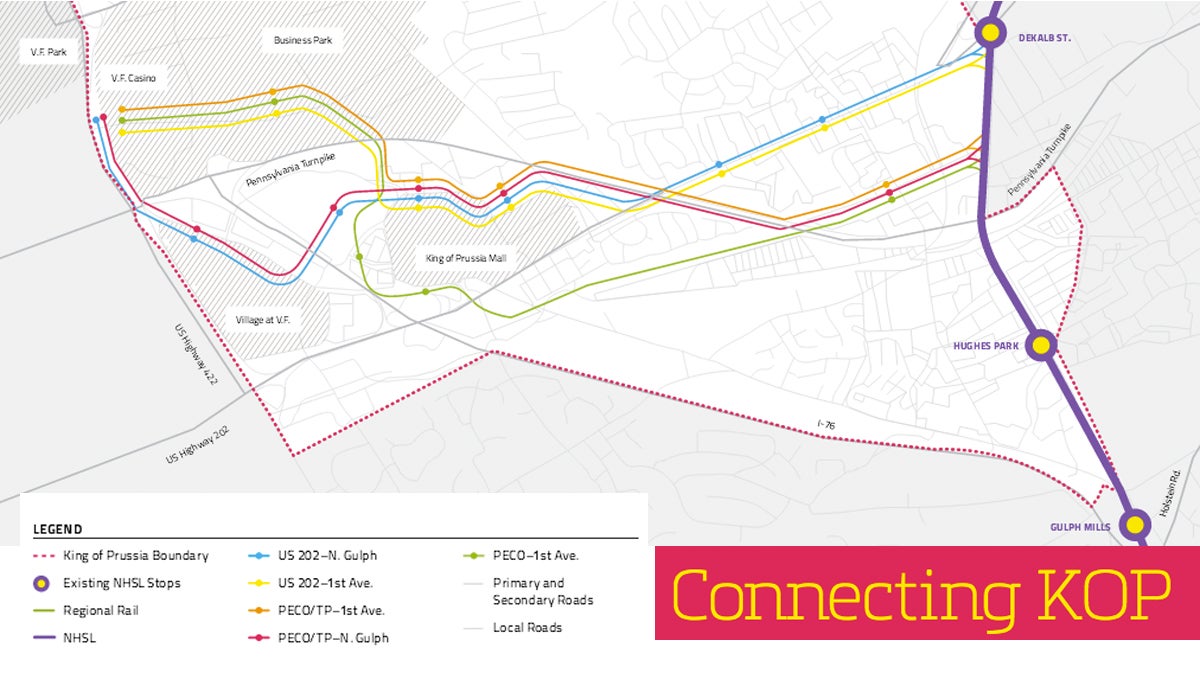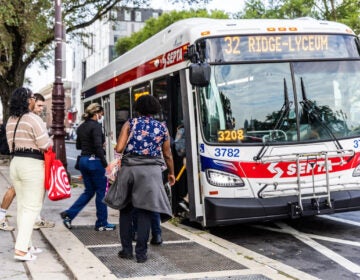Long-awaited train to King of Prussia would boost economy, study says
Listen
There are five possible routes for the proposed extension of the Norristown High Speed Line from 69th Street Station and the Norristown Transportation Center to King of Prussia. (Connecting KOP/The Economy League)
Someday, fighting for the deals at the country’s second largest mall may no longer mean fighting your way to a parking spot.
The proposed extension of the Norristown High Speed Line out to King of Prussia would not only reduce congestion on local roadways, according to a new report by the Economy League of Greater Philadelphia. It would also prove an economic boon nearby tourist attractions and office parks.
The report runs down everything from the reduction of air pollution to square feet of likely new development the extension could spur.
“Transit investment has been shown around the country and around the world to stimulate a variety of economic benefits, from construction spending, environmental and safety benefits that come from taking cars off the road and, in this case, travel times savings,” said Nick Fortino, the Economy League’s director for strategy and operations.
Estimates of benefits from the extension include:
shaving anywhere from 10 to 30 minutes off public transit commutes to the KOP mall from points in Philadelphia, Norristown and Upper Darby;
reducing some 1.7 million hours motorists spend on area highways each year, thanks to fewer commuters traveling by car;
and 310,000 square feet of new real estate development per year.
The idea for a Schuylkill railroad line toward King of Prussia and Reading has been kicked around for at least a decade, with the most recent iteration, a more modest extension of the Norristown High Speed Line, coming to the fore in 2012.
Since then, SEPTA used $20 million in federal funds to do some strategic planning, then banded together with local agencies such as the Delaware Valley Regional Planning Commission and the King of Prussia Business Improvement District to drum up support for the project.
This coordination is still in the early stages for a project that could take, at best, 10 years from planning to completion. Large-scale transportation improvements cost hundreds of millions of dollars for construction alone, and getting that money committed takes a long time.
Construction for the KOP extension is expected to cost from $1 billion to $1.2 billion.
In order to bolster that much financial support, compiling a report on the economic impact of the proposed extension makes strategic sense, according to Liz Smith, manager of long range planning for SEPTA. The information in the report is some of the very same that the federal government requires for what is called a New Start grant, from the Federal Transit Administration. If secured, Smith said, that grant would cover up to 50 percent of the project’s capital costs.
SEPTA has faced a variety of public challenges to its economic sustainability in recent years. Smith said she expects the rest of the funding to come from a variety of small sources, rather than a few large organizations.
“It’s tough to say for certain that it’s going to happen,” said Smith. But, she said she’s optimistic. The next step is figuring out which of five routes is the “locally preferred option.”
Once a route is chosen, residents with concerns about noise or property values may push back.
If all goes as planned, the new link would be up and running in 2023.
WHYY is your source for fact-based, in-depth journalism and information. As a nonprofit organization, we rely on financial support from readers like you. Please give today.
Long-awaited train to King of Prussia would boost economy, study says

Someday, fighting for the deals at the country’s second largest mall may no longer mean fighting your way to a parking spot.
The proposed extension of the Norristown High Speed Line out to King of Prussia would not only reduce congestion on local roadways, according to a new report by the Economy League of Greater Philadelphia. It would also prove an economic boon nearby tourist attractions and office parks.
The report runs down everything from the reduction of air pollution to square feet of likely new development the extension could spur.
“Transit investment has been shown around the country and around the world to stimulate a variety of economic benefits, from construction spending, environmental and safety benefits that come from taking cars off the road and, in this case, travel times savings,” said Nick Fortino, the Economy League’s director for strategy and operations.
Estimates of benefits from the extension include:
- shaving anywhere from 10 to 30 minutes off public transit commutes to the KOP mall from points in Philadelphia, Norristown and Upper Darby;
- reducing some 1.7 million hours motorists spend on area highways each year, thanks to fewer commuters traveling by car;
- and 310,000 square feet of new real estate development per year.
WHYY is your source for fact-based, in-depth journalism and information. As a nonprofit organization, we rely on financial support from readers like you. Please give today.





